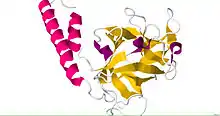Inositol trisphosphate receptor
Inositol trisphosphate receptor (InsP3R) is a membrane glycoprotein complex acting as a Ca2+ channel activated by inositol trisphosphate (InsP3). InsP3R is very diverse among organisms, and is necessary for the control of cellular and physiological processes including cell division, cell proliferation, apoptosis, fertilization, development, behavior, learning and memory.[2] Inositol triphosphate receptor represents a dominant second messenger leading to the release of Ca2+ from intracellular store sites. There is strong evidence suggesting that the InsP3R plays an important role in the conversion of external stimuli to intracellular Ca2+ signals characterized by complex patterns relative to both space and time, such as Ca2+ waves and oscillations.[3]
| inositol 1,4,5-trisphosphate receptor, type 1[1] | |||||||
|---|---|---|---|---|---|---|---|
 Crystal structure of the ligand binding suppressor domain of type 1 inositol 1,4,5-trisphosphate receptor | |||||||
| Identifiers | |||||||
| Symbol | ITPR1 | ||||||
| NCBI gene | 3708 | ||||||
| HGNC | 6180 | ||||||
| OMIM | 147265 | ||||||
| RefSeq | NM_002222 | ||||||
| UniProt | Q14643 | ||||||
| Other data | |||||||
| Locus | Chr. 3 p26.1 | ||||||
| |||||||
| inositol 1,4,5-trisphosphate receptor, type 3 | |||||||
|---|---|---|---|---|---|---|---|
| Identifiers | |||||||
| Symbol | ITPR3 | ||||||
| NCBI gene | 3710 | ||||||
| HGNC | 6182 | ||||||
| OMIM | 147267 | ||||||
| RefSeq | NM_002224 | ||||||
| UniProt | Q14573 | ||||||
| Other data | |||||||
| Locus | Chr. 6 p21.31 | ||||||
| |||||||
Discovery
The InsP3 receptor was first purified from rat cerebellum by neuroscientists Surachai Supattapone and Solomon Snyder at Johns Hopkins University School of Medicine.[4]
The cDNA of the InsP3 receptor was first cloned in the laboratory of Katsuhiko Mikoshiba. The initial sequencing was reported as an unknown protein enriched in the cerebellum called P400.[5] The large size of this open reading frame indicated a molecular weight similar to the protein purified biochemically, and soon thereafter it was confirmed that the protein p400 was in fact the inositol trisphosphate receptor.[6]
Distribution
The receptor has a broad tissue distribution but is especially abundant in the cerebellum. Most of the InsP3Rs are found integrated into the endoplasmic reticulum.
Structure
The asymmetric structure consists of an N-terminal beta-trefoil domain and a C-terminal alpha helical domain with a folding pattern similar to an armadillo repeat fold. The split formed by the two terminals contains multiple arginine and lysine residues that coordinate the three phosphoryl groups of InsP3R.[2] The InsP3R complex is formed of four 313 kDa subunits. In amphibians, fish and mammals, there are 3 paralogs and these can form homo- or hetero-oligomers. InsP3R-1 is the most widely expressed of these three and is found in all tissue types and all developmental stages of life. It is additionally the means for further InsP3 receptor diversity in that it has as many as four splice sites with as many as 9 different optional exons or exon variants. Combinations of these can be introduced into a given transcript in order to modulate its pharmacological activity.
See also
- Inositol
- Inositol phosphate
- MRVI1 associated through complex formation.
References
- Bosanac I, Yamazaki H, Matsu-Ura T, Michikawa T, Mikoshiba K, Ikura M (January 2005). "Crystal structure of the ligand binding suppressor domain of type 1 inositol 1,4,5-trisphosphate receptor". Mol. Cell. 17 (2): 193–203. doi:10.1016/j.molcel.2004.11.047. PMID 15664189.
- Bosanac I, Alattia JR, Mal TK, et al. (December 2002). "Structure of the inositol 1,4,5-trisphosphate receptor binding core in complex with its ligand". Nature. 420 (6916): 696–700. Bibcode:2002Natur.420..696B. doi:10.1038/nature01268. PMID 12442173. S2CID 4422308.
- Yoshida Y, Imai S (June 1997). "Structure and function of inositol 1,4,5-trisphosphate receptor". Jpn. J. Pharmacol. 74 (2): 125–37. doi:10.1254/jjp.74.125. PMID 9243320.
- Supattapone S, Worley PF, Baraban JM, Snyder SH (January 1988). "Solubilization, purification, and characterization of an inositol trisphosphate receptor" (PDF). The Journal of Biological Chemistry. 263 (3): 1530–4. doi:10.1016/S0021-9258(19)57336-7. PMID 2826483.
- Furuichi T, Yoshikawa S, Mikoshiba K (1989). "Nucleotide sequence of cDNA encoding P400 protein in the mouse cerebellum". Nucleic Acids Res. 17 (13): 5385–6. doi:10.1093/nar/17.13.5385. PMC 318125. PMID 2762133.
- Furuichi T, Yoshikawa S, Miyawaki A, Wada K, Maeda N, Mikoshiba K (1989). "Primary structure and functional expression of the inositol 1,4,5-trisphosphate-binding protein P400". Nature. 342 (6245): 32–8. Bibcode:1989Natur.342...32F. doi:10.1038/342032a0. PMID 2554142. S2CID 1781700.
External links
- Inositol+Trisphosphate+Receptor at the US National Library of Medicine Medical Subject Headings (MeSH)